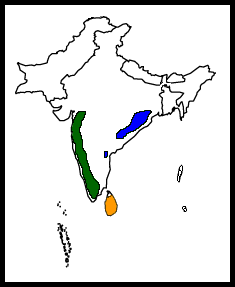Alternative names: Ceylon Trogon; Southern Trogon
- Harpactes fasciatus
Identification
29–30 cm (11½-11¾ in); a small Trogon.
- Bright rufous upperparts
- Blue orbital skin and bill
- White undertail
- Male with slaty head and breast, red underparts separated by white breast-band
- Female duller with ochre underparts, brown head, breast and mantle and cinnamon rump and tail
Variations
- Male malabaricus have a darker head, almost black
- Juveniles are like females but coverts are vermiculated buff
There is no confusion species within its range.
Distribution
| Endemic to the Indian Subcontinent. Found in India in the Western Ghats in the South West and in the Eastern Ghats (Andhra Pradesh, Orissa). Also on Sri Lanka.
Common in parts of its range (Kerala, Sinharaja Forest in Sri Lanka), uncommon and rare in others. | |
| Legend • M. f. malabaricus; year-round |
Taxonomy
Subspecies
There are 3 subspecies1:
- H. f. malabaricus - western to southern India
- H. f. legerli - not always recognized; eastern-central India
- H. f. fasciatus - Sri Lanka
Status of legerli
Though sequenced following the account for H. f. malabaricus by Clements (2007)1, H. f. legleri is not considered a valid subspecies by numerous worldwide and regional authors (Rasmussen & Anderton, 20052; Grimmett et al., 19983; Kazmiercak, 20004; Del Hoyo et al., 20016). In general, Rasmussen & Anderton (2005) is known for presenting imminent but pending taxonomic information based on scientific data. Within India, it unprecedentedly recognizes many theoretical species and subspecies, yet does not recognize legleri (attributes its range to malabaricus).
Habitat
Dense primary and secondary evergreen forest, semi-evergreen and deciduous forest. Prefers bamboo. Also recored in plantations (eg mahagony). Up to 1500m in India, 1800m in Sri Lanka.
Behaviour
Feed on insects (caterpillars, moths, beetles,...), takes also leaves and berries.
Breeding season from February to June. It nests in a hollow in a tree stump, with a typical clutch of 2-4 eggs.
Mainly resident, but some movement seems to occur around Bombay, where the species is only present during the cold season.
References
- Clements, J. F., T. S. Schulenberg, M. J. Iliff, D. Roberson, T. A. Fredericks, B. L. Sullivan, and C. L. Wood. 2018. The eBird/Clements checklist of birds of the world: v2018. Downloaded from http://www.birds.cornell.edu/clementschecklist/download/
- Rasmussen, PC and JC Anderton. 2005. Birds of South Asia: The Ripley Guide. Barcelona: Lynx Edicions. ISBN 978-8487334672
- Grimmett, R, C Inskipp, and T Inskipp. 1998. Birds of the Indian Subcontinent. London: Christopher Helm. ISBN 978-0713640045
- Kazmierczak, K and B van Perlo. 2000. A Field Guide to the Birds of the Indian Subcontinent. New Haven: Yale Univ. Press. ISBN 978-0300079210
- Kazmierczak, K and R Singh. 2001. A Birdwatcher's Guide to India. New Dehli: India Oxford Univ. Press. ISBN 978-1871104080
- Del Hoyo, J, A Elliot, and J Sargatal, eds. 2001. Handbook of the Birds of the World. Volume 6: Mousebirds to Hornbills. Barcelona: Lynx Edicions. ISBN 978-8487334306
Recommended Citation
- BirdForum Opus contributors. (2024) Malabar Trogon. In: BirdForum, the forum for wild birds and birding. Retrieved 26 April 2024 from https://www.birdforum.net/opus/Malabar_Trogon






